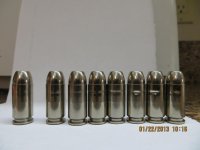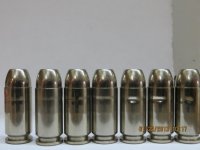fbcmrjrtykr
Member
- Joined
- Jul 11, 2013
- Messages
- 279
- Reaction score
- 91
i'm curious as to how many times one can safely chamber a round without inducing bullet setback? If I have to eject an unfired round (pistol cleaning or inspection) i always rotate a new round into the chamber, rather than re-feed the ejected round. I compare the ejected round to others to ensure it looks okay but have often wonder, as what point does the round become unsafe to use. If setback occurs, is there a point where the setback creates an over-pressure situation?
I check my rounds by placing them upright on a flat surface and placing a level across the top of the round. Is there a better to check for bullet setback? In that same vein, what do y'all check for when inspecting rounds?
Thanks,
JR
I check my rounds by placing them upright on a flat surface and placing a level across the top of the round. Is there a better to check for bullet setback? In that same vein, what do y'all check for when inspecting rounds?
Thanks,
JR


